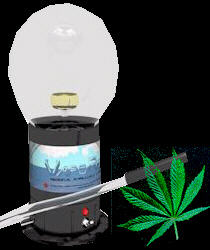 |


|
|
|
|
By Bruce Mirken
Vaporizers are designed to release the active ingredients of marijuana, known as cannabinoids, without actually burning the plant material. This is potentially important because it is these combustion products rather than the cannabinoids that are the source of the major health risks associated with smoking, and those risks have been cited by government officials and others as a major reason to prohibit or limit use of cannabis as a medicine. In its report, Marijuana and Medicine: Assessing the Science Base, released earlier this year, the Institute of Medicine cited the dangers of smoking as a major drawback. The IOM stated, "Numerous studies suggest that marijuana smoke is an important risk factor in the development of respiratory disease... Because of the health risks associated with smoking, smoked marijuana should generally not be recommended for long-term medical use." The IOM suggested that researchers concentrate on isolating medically useful cannabinoids and developing "rapid-onset, nonsmoked cannabinoid delivery systems." Such systems might be similar to the inhalers used for certain asthma medicines. While some critics argue that the IOM overemphasized the dangers of marijuana smoke, all acknowledge that the smoke does indeed contain many of the same harmful substances as tobacco smoke, including tars and carbon monoxide.
One of the scientists who reviewed the IOM report prior to its publication, Harvard assistant professor of psychiatry Lester Grinspoon, M.D., urged the IOM panel to consider the advantages of such a "non-smoked respiratory delivery system for the natural plant medicine" rather than putting the sole emphasis on pharmaceutical product development. The final report, however, makes no mention of such devices. Grinspoon, a longtime supporter of medicinal use of marijuana, charges that the omission is political rather than scientific. "What the report is doing is trying to pharmaceuticalize away the medical marijuana problem," he argues. "What they're doing now that they have to grudgingly acknowledge that this substance has some use [is to say] 'how do we make it a medicine and keep this prohibition?'" As for the vaporizers presently available, Grinspoon says, "I've tested three such devices. There's no question that these things work. They haven't been tested in the laboratory, but there's no question that cannabinoids come off and when you look at the [marijuana] in the end it looks just like it did; it's not burnt." Two medical cannabis club managers consulted by AIDS Treatment News, Ken Hayes of CHAMP in San Francisco and Jeff Jones of the Oakland Cannabis Buyers' Cooperative, both shared Grinspoon's enthusiasm for vaporizers. Vaporizer makers tout two advantages: Avoidance of unhealthful combustion products and more complete use of the active ingredients. Considerable amounts of cannabinoids, they say, are wasted when the herb is burned, so vaporizers are more efficient and economical than conventional smoking. Unfortunately, the only study to examine these issues scientifically is over three years old and did not involve the vaporizers currently marketed. The study, conducted by MAPS and NORML and described in Gieringer's 1996 article, compared three different water pipes, an early Canadian vaporizer and a homemade vaporizer/water pipe hybrid to an ordinary joint [marijuana cigarette] and a joint with a cigarette filter.
Surprisingly, the water pipes performed worse than the unfiltered joint, suggesting that "water filtration is actually counterproductive, apparently because water tends to absorb THC [tetrahydrocannabinol, the main psychoactive ingredient of marijuana] more readily than noxious tars." The vaporizer without the water pipe component did best, producing a cannabinoid/tar ratio "about 25 percent higher than the unfiltered joint." (An unexplained finding, though, was that the vapors from the vaporizer contained a higher than normal amount of cannabinol, a cannabinoid that is less psychoactive than THC but which may have medicinal benefits. The THC/tar ratio for the vaporizer was somewhat lower than the unfiltered joint.) Overall, Gieringer concluded that the study shows great potential for vaporizers but that "more developmental work needs to be done." Since that article was published a number of vaporizers have been developed and sold through a variety of outlets, including head shops, medical cannabis clubs and on the Internet. Developers of the individual products tend to claim great benefits and several have ardent fans, but at present there is no scientific data to verify the efficiency or cannabinoid/tar ratios of these devices. AIDS Treatment News received a demonstration of two vaporizers, the VaporTech Vaporizer from Florida-based VaporTech, and the Volatilizer, from California-based Chirotech. Both products appear to do what they claim to do: vaporize the active ingredients without actual combustion. Subjectively, users report that the vapors are notably less harsh than conventional smoke, while being at least as potent and perhaps more so. The Volatilizer, a favorite of the staff at CHAMP, consists of a wand-like device which plugs into an electrical outlet and has a round heating element at the end. The heating element is designed to fit over a special bowl, which can be used with the user's own pipe or bong. It sells for $199.95. VaporTech's unit is somewhat more complex, with about half a dozen separate pieces. The marijuana is placed in a small test tube which is placed in the unit and heated, and the vapors are inhaled through a plastic tube. Some users complain that the VaporTech gets too hot, and marijuana left in it more than a few minutes will burn, but this does not appear to be a problem if one uses the material relatively quickly. The VaporTech sells for $140 plus shipping charges. A number of other vaporizers, which we have not had the opportunity to see demonstrated, are also available. These include the Omega Vaporizer, which is normally carried at the Oakland CBC's Hemp Store but was out of stock when this article was being prepared. Several products, including the Vaportron, VapoRizit and the British Vapouriser use a roughly similar design, with a small bowl to hold the marijuana placed over a heating element, all enclosed by a dome to retain the vapors. These relatively simple designs tend to be less expensive than the others, generally in a range from $60-$100. Sources of further information, including instructions for building a homemade unit, are listed below. Although everyone we spoke to had a favorite model, there is at present no scientific data comparing the products with each other or with conventional smoking. Such a comparison would not be difficult to do with the proper equipment and lab facilities, and a number of entities are interested in pursuing such research, including CHAMP and MAPS. Money is one obstacle, notes Gieringer, as the study would be relatively expensive and there is no pharmaceutical company to finance it. The firms now marketing vaporizers are all tiny, with nowhere near the resources of even a medium-sized drug company. The other obstacle is the continuing prohibition of marijuana, since tobacco can't be substituted for marijuana in vaporizer tests. Indeed, drug paraphernalia laws now constrain vaporizer companies from even discussing marijuana in their publicity materials, and the obstacles to medical marijuana research remain high. Chuck Thomas of the Marijuana Policy Project notes that a well-publicized easing of restrictions announced earlier this year was only a small step in the right direction. "Health and Human Services still makes it unnecessarily difficult to do medical marijuana research," he says. "The HHS guidelines still say a special Public Health Service review is necessary. The question is, why? You can study thalidomide without a PHS review, and I don't think anyone in their right mind believes that marijuana is more dangerous than thalidomide." References and Information Sources Dale Gieringer's article, "Marijuana Water Pipe and Vaporizer Study," which appeared in the Newsletter of the Multidisciplinary Association for Psychedelic Studies, volume 6, number 3, Summer, 1996 is available online at the MAPS Web site, www.maps.org/news-letters/v06n3/06359mj1.html . The Institute of Medicine Report, Marijuana and Medicine Assessing the Science Base, can be purchased from the National Academy of Sciences, (800)624-6242 and is available free online at books.nap.edu/html/marimed/notice.html . Lester Grinspoon's critique of the report is online at www.rxmarijuana.com/iomreview.htm. Vaporizer product information: VaporTech: http:www.vaportechco.com , or 888-453-1996, vaportech@yahoo.com . Vaportron (Vaporware): (888)276-7927, or www.vaporware.net . Vapouriser: www.virtual-shops.net/chillabong/vapouriser.html (NOTE: Although the information on the Web site did not make this clear, this British unit will need an adapter to be used with standard U.S. electric current). Volatilizer: (800)485-7305. Omega Vaporizer: Available through the Oakland CBC, (510)832- 5346. VapoRizit: 3089-C Clairemont Dr., Unit 34, San Diego, CA 92117, info@vaporizer.com , www.vaporizer.com . A number of other Internet sites feature information on vaporizers, including basic explanations, personal experiences and do-it-yourself instructions for making your own. A Web search using the term "vaporizer" will turn up a number of listings. One with particularly extensive information is nepenthes.lycaeum.org/Drugs/THC/Vaporize/index.html Other do-it-yourself instructions are at www.angelfire.com/ga/greenmanspage/vaporizer.html and people.delphi.com/sjc/drugs/weed/mj_vaps.html Like much that is available on the Internet, the information on these sites, including the vaporizer plans, should be regarded as anecdotal and unverified. AIDS Treatment News Published twice monthly Subscription and Editorial Office: P.O. Box 411256 San Francisco, CA 94141 800/TREAT-1-2 toll-free U.S. and Canada 415/255-0588 regular office number Fax: 415/255-4659 E-mail: aidsnews@aidsnews.org
Editor and Publisher: John S. James Associate Editor: Tadd T. Tobias Reader Services: Tom Fontaine and Denny Smith Operations Manager: Danalan Richard Copeland Statement of Purpose: AIDS Treatment News reports on experimental and standard treatments, especially those available now. We interview physicians, scientists, other health professionals, and persons with AIDS or HIV; we also collect information from meetings and conferences, medical journals, and computer databases. Long-term survivors have usually tried many different treatments, and found combinations which work for them. AIDS Treatment News does not recommend particular therapies, but seeks to increase the options available. Subscription Information: Call 800/TREAT-1-2 Businesses, Institutions, Professionals: $270/year. Includes early delivery of an extra copy by email. Nonprofit organizations: $135/year. Includes early delivery of an extra copy by email. Individuals: $120/year, or $70 for six months. Special discount for persons with financial difficulties: $54/year, or $30 for six months. If you cannot afford a subscription, please write or call. Outside North, Central, or South America, add air mail postage: $20/year, $10 for six months. Back issues available. Fax subscriptions, bulk rates, and multiple subscriptions are available; contact our office for details. Please send U.S. funds: personal check or bank draft, international postal money order, or travelers checks. ISSN # 1052-4207 Copyright 1999 by John S. James. |

© 1997-98 BEI

 The smoke produced by each was analyzed for
solid particulates (tars) and 3 major cannabinoids. The
various smoking methods were then rated based on their
cannabinoid-to-tar ratio.
The smoke produced by each was analyzed for
solid particulates (tars) and 3 major cannabinoids. The
various smoking methods were then rated based on their
cannabinoid-to-tar ratio.